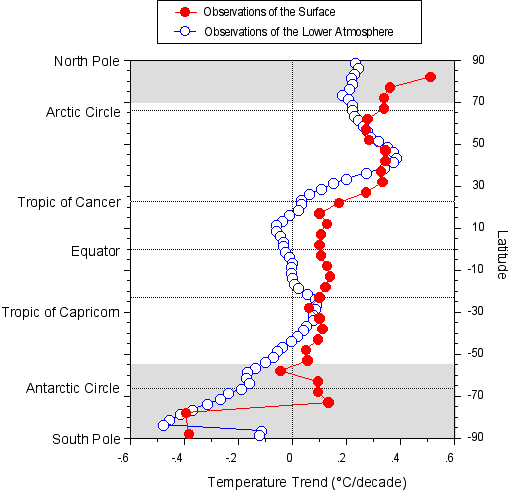
National Energy spokesman Roger Sowry has confirmed National's opposition to carbon taxes under the Kyoto agreement.
"National has serious questions about the Kyoto protocol and thinks it was very unwise for New Zealand to take on these obligations before our key trading partners had signed the protocol.
"Our CO2 emissions are half those of Australia and the United States on a per capita basis. Our businesses should not have to face an unnecessary carbon tax which will undermine their competitiveness.
"National will not impose a carbon tax and will review our obligations under Kyoto to ensure New Zealand businesses are not disadvantaged," said Mr Sowry.
Global Warming Revisited
I have had to revise my attitude to global warming as a result of my recent analysis of regional temperature trends.
You will all be aware that there is a discrepancy between the opinions of the scientific groups who derive trends in global surface temperature and those who measure global temperature in the lower troposphere (weather balloons and satellites). A more detailed examination of the regional comparisons between the two methods show that the discrepancy does not exist in some cases but is rather startling in others.
Take, to start with, the published temperature trends per decade for the two hemispheres shown by the satellite measurements (MSU) between 1979 and 2004.
The trend in the Northern Hemisphere was 0.153°C per decade
The trend in the Southern Hemisphere was 0.012°C per decade.
Now, the Northern Hemisphere is 49.1% land, and the Southern Hemisphere is 15.2% land. By simple algebra it is possible to calculate the separate figures for land and sea, which come out as follows
Trend over land 1979-2004 was + 0.36°C per decade
Trend over sea 1979-2004 was -0.05°C
So, while the land temperatures were rising the sea temperature was falling.
This disagrees completely with the computer models, which postulate that sulphate-based clouds, which are mainly on land, cause cooling, so that the land should warm less than the sea. Yet we find the sea is not warming at all, but cooling. How can that be consistent with "global warming".
The surface measurements also show that land increases are greater than sea increases. The Jones temperature measurements 1979-2000 increased 0.25°C per decade over land and only 0.15°C over the sea.
So, the MSU increase over land was 50% greater than the surface increase. The only explanation I can think of is the 1998 El Niño event which was much more drastic in the lower troposphere than on the surface, and has boosted the trend. But El Niño is supposed to take place over the sea, yet sea temperatures have not increased. The explanation for this is seen in some recent TOPEX satellite measurements of sea surface temperature which show that the sea surface temperature did indeed rise in 1998, but it came down again to its early value. Over land it only came down part of the way.
The reason the surface people find a distinct trend over the sea is almost certainly the bias in ship measurements, which are made by cooling water intakes, distorted by the size and luxury of the ship.
Regional comparisons between the MSU and the surface are also revealing. First, I must admit, that both methods agree over the major industrial countries, USA, Europe, Russia, Australia and presumably New Zealand. If all the measurements agree they must be right, so I have to withdraw my previous statements that weather stations in these countries could be seriously biased by urban heating.
The attached latitude graph (latitude-temp-trends) shows a comparison between the MSU and the surface by latitude. Points to note are as follows:
The two methods agree for latitude bands 35° to 60°, -35° to -27°, and -80°
The biggest discrepancies are above the Arctic Circle, +35° to Tropic of Capricorn and around the Arctic Circle. There is a major reversal of opinion at the South Polewhere the Surface finds -4°C/decade and the MSU finds only -1°C per decade.
The discrepancy around the equator can be attributed to upwards bias in surface measurements in those countries with less well financed and supervised measurement systems. The discrepancies in the Arctic and Antarctic peninsula must be due to the impossibility of eliminating human influence.
Since the MSU shows a temperature fall over the Antarctic the rise over the remaining land must be higher than the 0.36°C per decade average.
It remains very difficult to explain why all the warming takes place over land, a fact completely incompatible with all current models. One of my correspondents, Doug Hoyt, thinks it is because the extra carbon dioxide provides more green vefetation, and he has some graphs to prove it. Other possibilities are extra black carbon and land-use changes.
We seem to be a long way away from explaining current changes in our climate.
Vincent Gray
75 Silverstream Road
Crofton Downs
Wellington 6004
New Zealand
Phone/Fax (064) 4 9735939
Email vinmary.gray@paradise.net.nz
"It's not the things you don't know that fool you.
It's the things you do know that ain't so"
Josh Billings
